Analysis of Mental Health Clinical Placement for Nursing Students
VerifiedAdded on 2023/04/20
|13
|4351
|364
Essay
AI Summary
This essay critically appraises a qualitative research paper focusing on mental health nursing clinical placements, specifically examining the experiences of nursing students in an innovative 'Recovery group' setting. The paper evaluates various aspects of the research, including the study design, research framework, methodology, and findings, using the CASP critical appraisal tool. It highlights the relevance of transition programs in nursing, particularly in mental health, to address challenges such as lack of confidence and clinical experience among new nurses. The appraisal identifies strengths such as a clear research question and appropriate philosophical underpinning, while also noting limitations like the lack of an exhaustive literature review, absence of a conceptual framework, and insufficient justification of philosophical assumptions. The essay emphasizes the importance of evidence-based practices in improving patient care outcomes and reducing medical errors, advocating for the integration of transition programs to foster a culture of continuous improvement in healthcare quality. Desklib offers a variety of solved assignments and past papers to aid students in their studies.
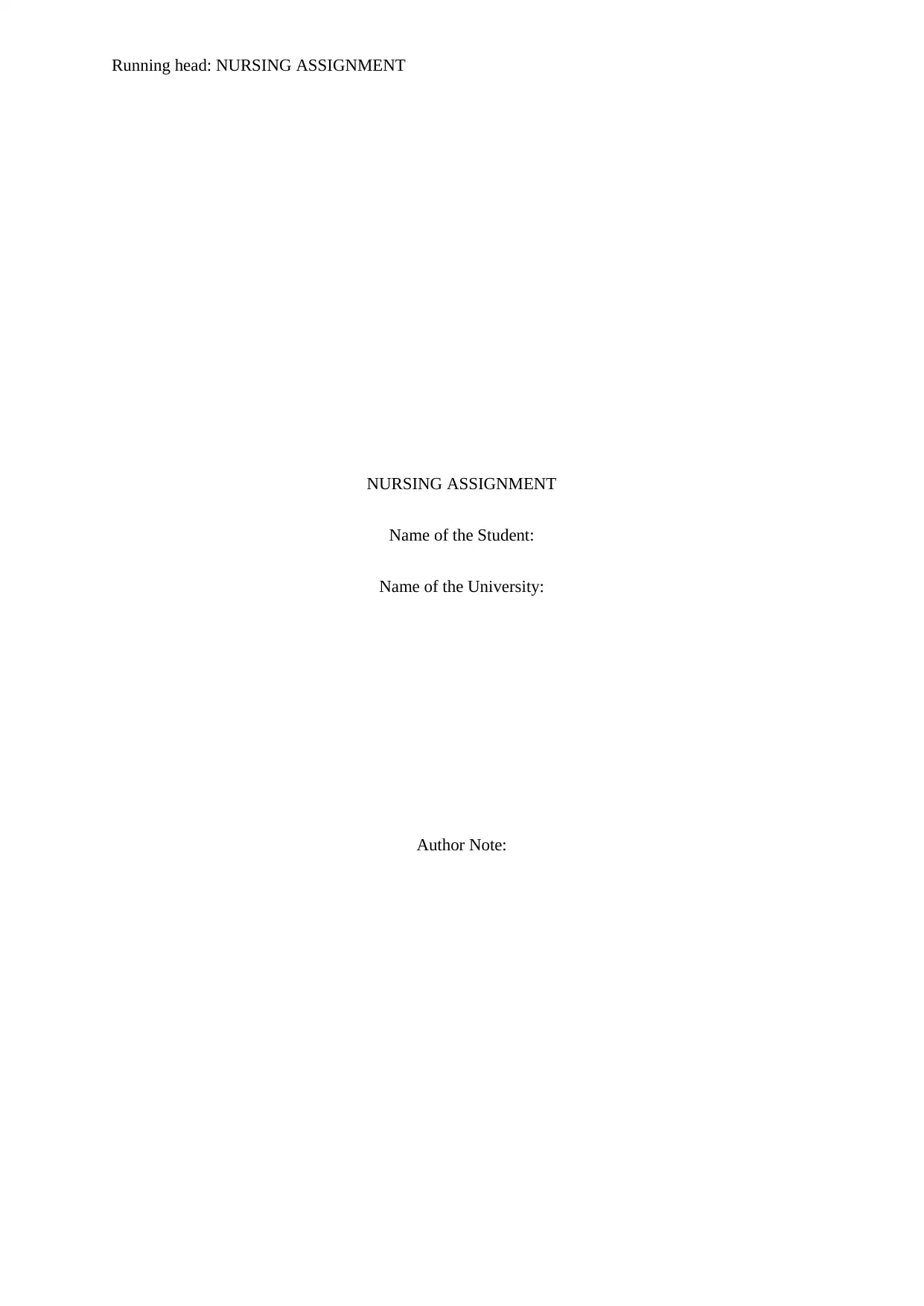
Running head: NURSING ASSIGNMENT
NURSING ASSIGNMENT
Name of the Student:
Name of the University:
Author Note:
NURSING ASSIGNMENT
Name of the Student:
Name of the University:
Author Note:
Paraphrase This Document
Need a fresh take? Get an instant paraphrase of this document with our AI Paraphraser
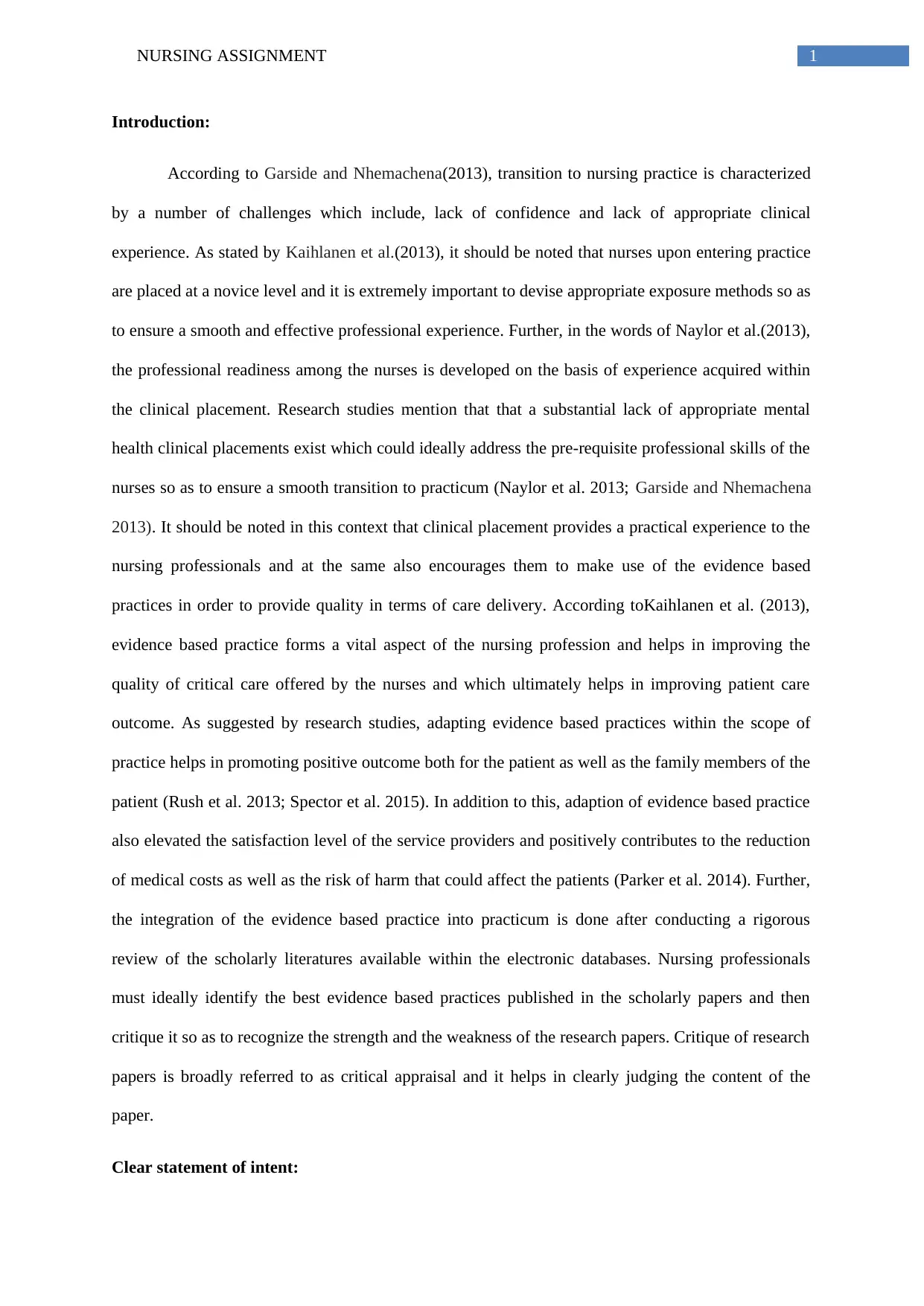
1NURSING ASSIGNMENT
Introduction:
According to Garside and Nhemachena(2013), transition to nursing practice is characterized
by a number of challenges which include, lack of confidence and lack of appropriate clinical
experience. As stated by Kaihlanen et al.(2013), it should be noted that nurses upon entering practice
are placed at a novice level and it is extremely important to devise appropriate exposure methods so as
to ensure a smooth and effective professional experience. Further, in the words of Naylor et al.(2013),
the professional readiness among the nurses is developed on the basis of experience acquired within
the clinical placement. Research studies mention that that a substantial lack of appropriate mental
health clinical placements exist which could ideally address the pre-requisite professional skills of the
nurses so as to ensure a smooth transition to practicum (Naylor et al. 2013; Garside and Nhemachena
2013). It should be noted in this context that clinical placement provides a practical experience to the
nursing professionals and at the same also encourages them to make use of the evidence based
practices in order to provide quality in terms of care delivery. According toKaihlanen et al. (2013),
evidence based practice forms a vital aspect of the nursing profession and helps in improving the
quality of critical care offered by the nurses and which ultimately helps in improving patient care
outcome. As suggested by research studies, adapting evidence based practices within the scope of
practice helps in promoting positive outcome both for the patient as well as the family members of the
patient (Rush et al. 2013; Spector et al. 2015). In addition to this, adaption of evidence based practice
also elevated the satisfaction level of the service providers and positively contributes to the reduction
of medical costs as well as the risk of harm that could affect the patients (Parker et al. 2014). Further,
the integration of the evidence based practice into practicum is done after conducting a rigorous
review of the scholarly literatures available within the electronic databases. Nursing professionals
must ideally identify the best evidence based practices published in the scholarly papers and then
critique it so as to recognize the strength and the weakness of the research papers. Critique of research
papers is broadly referred to as critical appraisal and it helps in clearly judging the content of the
paper.
Clear statement of intent:
Introduction:
According to Garside and Nhemachena(2013), transition to nursing practice is characterized
by a number of challenges which include, lack of confidence and lack of appropriate clinical
experience. As stated by Kaihlanen et al.(2013), it should be noted that nurses upon entering practice
are placed at a novice level and it is extremely important to devise appropriate exposure methods so as
to ensure a smooth and effective professional experience. Further, in the words of Naylor et al.(2013),
the professional readiness among the nurses is developed on the basis of experience acquired within
the clinical placement. Research studies mention that that a substantial lack of appropriate mental
health clinical placements exist which could ideally address the pre-requisite professional skills of the
nurses so as to ensure a smooth transition to practicum (Naylor et al. 2013; Garside and Nhemachena
2013). It should be noted in this context that clinical placement provides a practical experience to the
nursing professionals and at the same also encourages them to make use of the evidence based
practices in order to provide quality in terms of care delivery. According toKaihlanen et al. (2013),
evidence based practice forms a vital aspect of the nursing profession and helps in improving the
quality of critical care offered by the nurses and which ultimately helps in improving patient care
outcome. As suggested by research studies, adapting evidence based practices within the scope of
practice helps in promoting positive outcome both for the patient as well as the family members of the
patient (Rush et al. 2013; Spector et al. 2015). In addition to this, adaption of evidence based practice
also elevated the satisfaction level of the service providers and positively contributes to the reduction
of medical costs as well as the risk of harm that could affect the patients (Parker et al. 2014). Further,
the integration of the evidence based practice into practicum is done after conducting a rigorous
review of the scholarly literatures available within the electronic databases. Nursing professionals
must ideally identify the best evidence based practices published in the scholarly papers and then
critique it so as to recognize the strength and the weakness of the research papers. Critique of research
papers is broadly referred to as critical appraisal and it helps in clearly judging the content of the
paper.
Clear statement of intent:
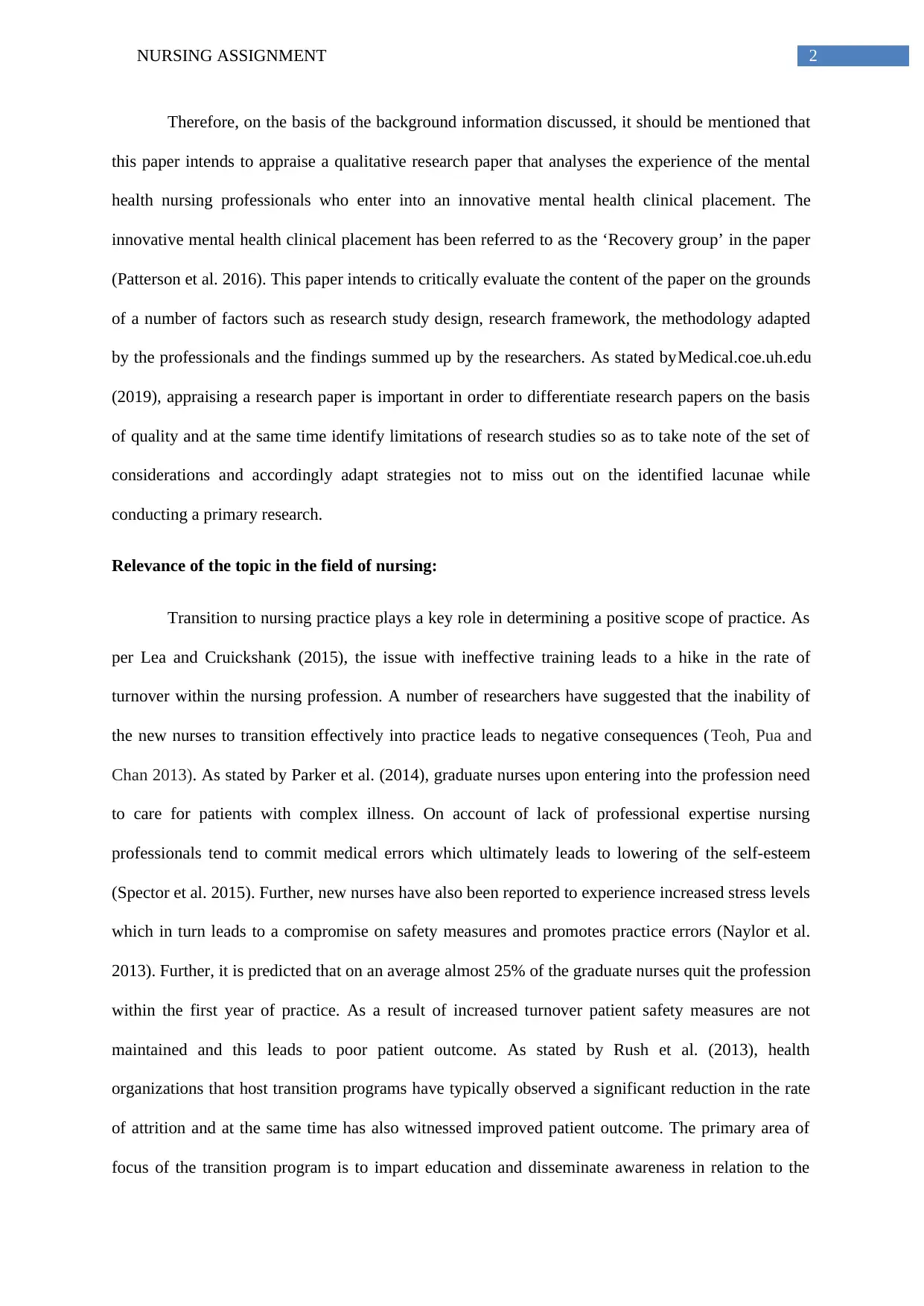
2NURSING ASSIGNMENT
Therefore, on the basis of the background information discussed, it should be mentioned that
this paper intends to appraise a qualitative research paper that analyses the experience of the mental
health nursing professionals who enter into an innovative mental health clinical placement. The
innovative mental health clinical placement has been referred to as the ‘Recovery group’ in the paper
(Patterson et al. 2016). This paper intends to critically evaluate the content of the paper on the grounds
of a number of factors such as research study design, research framework, the methodology adapted
by the professionals and the findings summed up by the researchers. As stated byMedical.coe.uh.edu
(2019), appraising a research paper is important in order to differentiate research papers on the basis
of quality and at the same time identify limitations of research studies so as to take note of the set of
considerations and accordingly adapt strategies not to miss out on the identified lacunae while
conducting a primary research.
Relevance of the topic in the field of nursing:
Transition to nursing practice plays a key role in determining a positive scope of practice. As
per Lea and Cruickshank (2015), the issue with ineffective training leads to a hike in the rate of
turnover within the nursing profession. A number of researchers have suggested that the inability of
the new nurses to transition effectively into practice leads to negative consequences (Teoh, Pua and
Chan 2013). As stated by Parker et al. (2014), graduate nurses upon entering into the profession need
to care for patients with complex illness. On account of lack of professional expertise nursing
professionals tend to commit medical errors which ultimately leads to lowering of the self-esteem
(Spector et al. 2015). Further, new nurses have also been reported to experience increased stress levels
which in turn leads to a compromise on safety measures and promotes practice errors (Naylor et al.
2013). Further, it is predicted that on an average almost 25% of the graduate nurses quit the profession
within the first year of practice. As a result of increased turnover patient safety measures are not
maintained and this leads to poor patient outcome. As stated by Rush et al. (2013), health
organizations that host transition programs have typically observed a significant reduction in the rate
of attrition and at the same time has also witnessed improved patient outcome. The primary area of
focus of the transition program is to impart education and disseminate awareness in relation to the
Therefore, on the basis of the background information discussed, it should be mentioned that
this paper intends to appraise a qualitative research paper that analyses the experience of the mental
health nursing professionals who enter into an innovative mental health clinical placement. The
innovative mental health clinical placement has been referred to as the ‘Recovery group’ in the paper
(Patterson et al. 2016). This paper intends to critically evaluate the content of the paper on the grounds
of a number of factors such as research study design, research framework, the methodology adapted
by the professionals and the findings summed up by the researchers. As stated byMedical.coe.uh.edu
(2019), appraising a research paper is important in order to differentiate research papers on the basis
of quality and at the same time identify limitations of research studies so as to take note of the set of
considerations and accordingly adapt strategies not to miss out on the identified lacunae while
conducting a primary research.
Relevance of the topic in the field of nursing:
Transition to nursing practice plays a key role in determining a positive scope of practice. As
per Lea and Cruickshank (2015), the issue with ineffective training leads to a hike in the rate of
turnover within the nursing profession. A number of researchers have suggested that the inability of
the new nurses to transition effectively into practice leads to negative consequences (Teoh, Pua and
Chan 2013). As stated by Parker et al. (2014), graduate nurses upon entering into the profession need
to care for patients with complex illness. On account of lack of professional expertise nursing
professionals tend to commit medical errors which ultimately leads to lowering of the self-esteem
(Spector et al. 2015). Further, new nurses have also been reported to experience increased stress levels
which in turn leads to a compromise on safety measures and promotes practice errors (Naylor et al.
2013). Further, it is predicted that on an average almost 25% of the graduate nurses quit the profession
within the first year of practice. As a result of increased turnover patient safety measures are not
maintained and this leads to poor patient outcome. As stated by Rush et al. (2013), health
organizations that host transition programs have typically observed a significant reduction in the rate
of attrition and at the same time has also witnessed improved patient outcome. The primary area of
focus of the transition program is to impart education and disseminate awareness in relation to the
⊘ This is a preview!⊘
Do you want full access?
Subscribe today to unlock all pages.

Trusted by 1+ million students worldwide
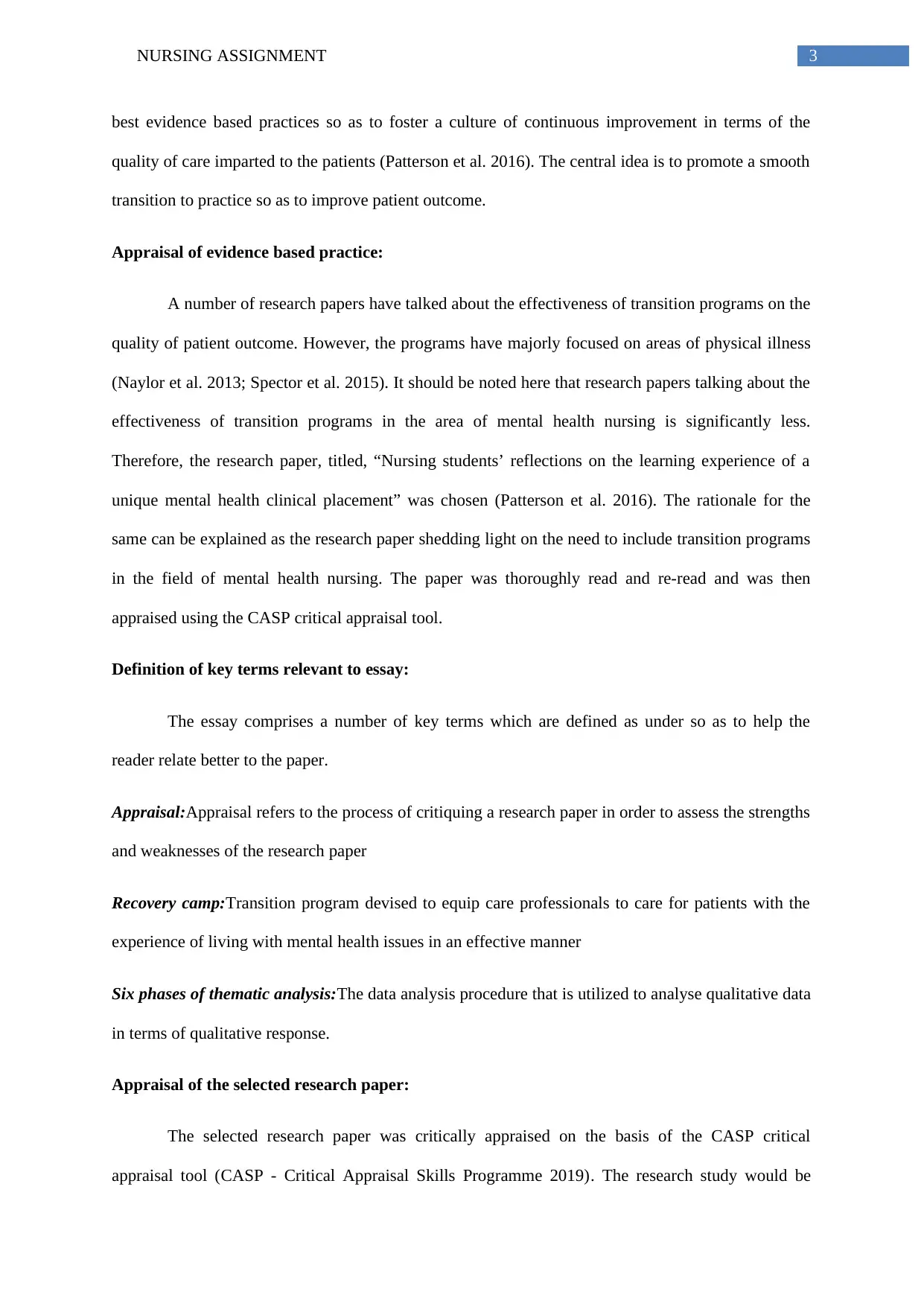
3NURSING ASSIGNMENT
best evidence based practices so as to foster a culture of continuous improvement in terms of the
quality of care imparted to the patients (Patterson et al. 2016). The central idea is to promote a smooth
transition to practice so as to improve patient outcome.
Appraisal of evidence based practice:
A number of research papers have talked about the effectiveness of transition programs on the
quality of patient outcome. However, the programs have majorly focused on areas of physical illness
(Naylor et al. 2013; Spector et al. 2015). It should be noted here that research papers talking about the
effectiveness of transition programs in the area of mental health nursing is significantly less.
Therefore, the research paper, titled, “Nursing students’ reflections on the learning experience of a
unique mental health clinical placement” was chosen (Patterson et al. 2016). The rationale for the
same can be explained as the research paper shedding light on the need to include transition programs
in the field of mental health nursing. The paper was thoroughly read and re-read and was then
appraised using the CASP critical appraisal tool.
Definition of key terms relevant to essay:
The essay comprises a number of key terms which are defined as under so as to help the
reader relate better to the paper.
Appraisal:Appraisal refers to the process of critiquing a research paper in order to assess the strengths
and weaknesses of the research paper
Recovery camp:Transition program devised to equip care professionals to care for patients with the
experience of living with mental health issues in an effective manner
Six phases of thematic analysis:The data analysis procedure that is utilized to analyse qualitative data
in terms of qualitative response.
Appraisal of the selected research paper:
The selected research paper was critically appraised on the basis of the CASP critical
appraisal tool (CASP - Critical Appraisal Skills Programme 2019). The research study would be
best evidence based practices so as to foster a culture of continuous improvement in terms of the
quality of care imparted to the patients (Patterson et al. 2016). The central idea is to promote a smooth
transition to practice so as to improve patient outcome.
Appraisal of evidence based practice:
A number of research papers have talked about the effectiveness of transition programs on the
quality of patient outcome. However, the programs have majorly focused on areas of physical illness
(Naylor et al. 2013; Spector et al. 2015). It should be noted here that research papers talking about the
effectiveness of transition programs in the area of mental health nursing is significantly less.
Therefore, the research paper, titled, “Nursing students’ reflections on the learning experience of a
unique mental health clinical placement” was chosen (Patterson et al. 2016). The rationale for the
same can be explained as the research paper shedding light on the need to include transition programs
in the field of mental health nursing. The paper was thoroughly read and re-read and was then
appraised using the CASP critical appraisal tool.
Definition of key terms relevant to essay:
The essay comprises a number of key terms which are defined as under so as to help the
reader relate better to the paper.
Appraisal:Appraisal refers to the process of critiquing a research paper in order to assess the strengths
and weaknesses of the research paper
Recovery camp:Transition program devised to equip care professionals to care for patients with the
experience of living with mental health issues in an effective manner
Six phases of thematic analysis:The data analysis procedure that is utilized to analyse qualitative data
in terms of qualitative response.
Appraisal of the selected research paper:
The selected research paper was critically appraised on the basis of the CASP critical
appraisal tool (CASP - Critical Appraisal Skills Programme 2019). The research study would be
Paraphrase This Document
Need a fresh take? Get an instant paraphrase of this document with our AI Paraphraser
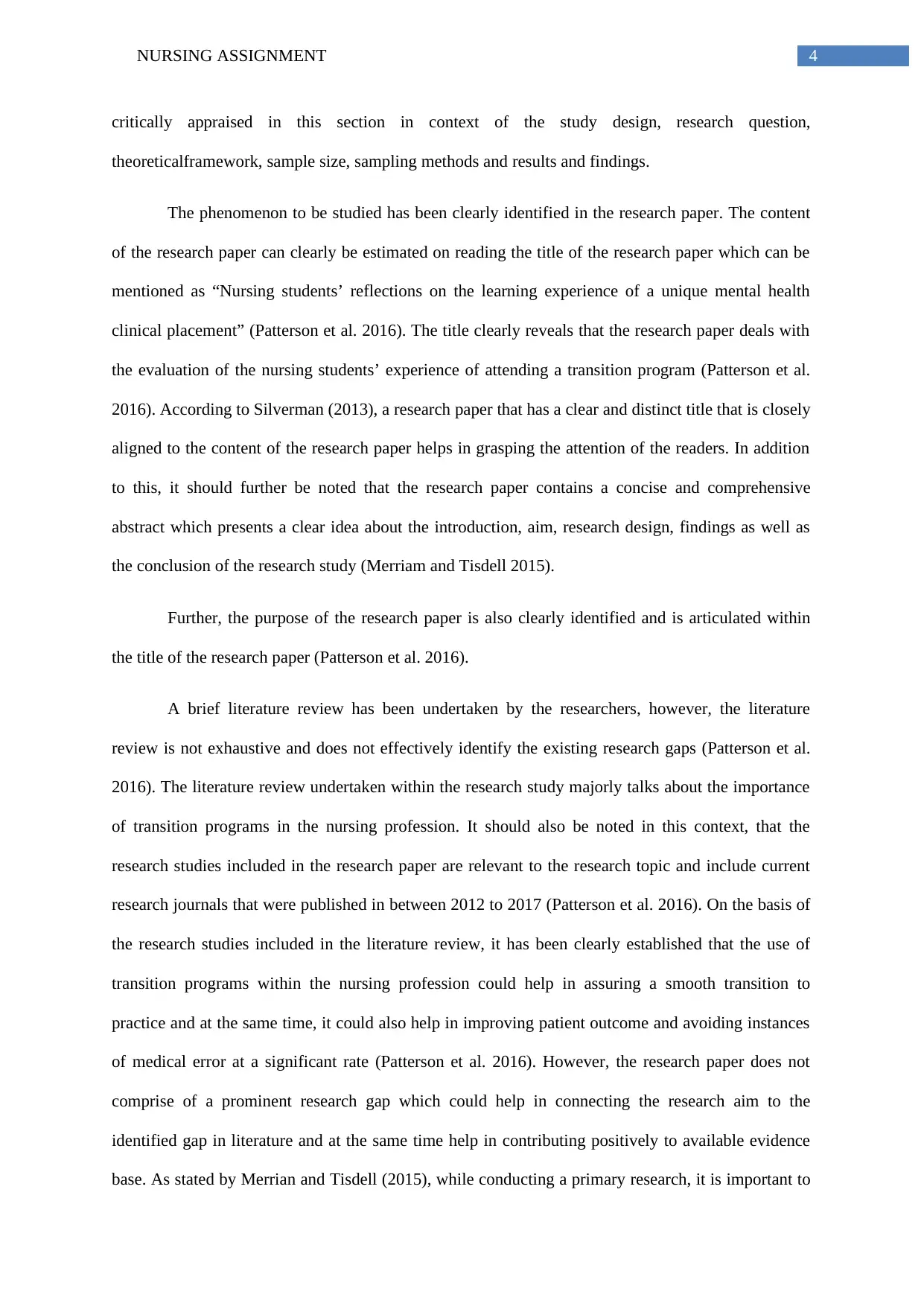
4NURSING ASSIGNMENT
critically appraised in this section in context of the study design, research question,
theoreticalframework, sample size, sampling methods and results and findings.
The phenomenon to be studied has been clearly identified in the research paper. The content
of the research paper can clearly be estimated on reading the title of the research paper which can be
mentioned as “Nursing students’ reflections on the learning experience of a unique mental health
clinical placement” (Patterson et al. 2016). The title clearly reveals that the research paper deals with
the evaluation of the nursing students’ experience of attending a transition program (Patterson et al.
2016). According to Silverman (2013), a research paper that has a clear and distinct title that is closely
aligned to the content of the research paper helps in grasping the attention of the readers. In addition
to this, it should further be noted that the research paper contains a concise and comprehensive
abstract which presents a clear idea about the introduction, aim, research design, findings as well as
the conclusion of the research study (Merriam and Tisdell 2015).
Further, the purpose of the research paper is also clearly identified and is articulated within
the title of the research paper (Patterson et al. 2016).
A brief literature review has been undertaken by the researchers, however, the literature
review is not exhaustive and does not effectively identify the existing research gaps (Patterson et al.
2016). The literature review undertaken within the research study majorly talks about the importance
of transition programs in the nursing profession. It should also be noted in this context, that the
research studies included in the research paper are relevant to the research topic and include current
research journals that were published in between 2012 to 2017 (Patterson et al. 2016). On the basis of
the research studies included in the literature review, it has been clearly established that the use of
transition programs within the nursing profession could help in assuring a smooth transition to
practice and at the same time, it could also help in improving patient outcome and avoiding instances
of medical error at a significant rate (Patterson et al. 2016). However, the research paper does not
comprise of a prominent research gap which could help in connecting the research aim to the
identified gap in literature and at the same time help in contributing positively to available evidence
base. As stated by Merrian and Tisdell (2015), while conducting a primary research, it is important to
critically appraised in this section in context of the study design, research question,
theoreticalframework, sample size, sampling methods and results and findings.
The phenomenon to be studied has been clearly identified in the research paper. The content
of the research paper can clearly be estimated on reading the title of the research paper which can be
mentioned as “Nursing students’ reflections on the learning experience of a unique mental health
clinical placement” (Patterson et al. 2016). The title clearly reveals that the research paper deals with
the evaluation of the nursing students’ experience of attending a transition program (Patterson et al.
2016). According to Silverman (2013), a research paper that has a clear and distinct title that is closely
aligned to the content of the research paper helps in grasping the attention of the readers. In addition
to this, it should further be noted that the research paper contains a concise and comprehensive
abstract which presents a clear idea about the introduction, aim, research design, findings as well as
the conclusion of the research study (Merriam and Tisdell 2015).
Further, the purpose of the research paper is also clearly identified and is articulated within
the title of the research paper (Patterson et al. 2016).
A brief literature review has been undertaken by the researchers, however, the literature
review is not exhaustive and does not effectively identify the existing research gaps (Patterson et al.
2016). The literature review undertaken within the research study majorly talks about the importance
of transition programs in the nursing profession. It should also be noted in this context, that the
research studies included in the research paper are relevant to the research topic and include current
research journals that were published in between 2012 to 2017 (Patterson et al. 2016). On the basis of
the research studies included in the literature review, it has been clearly established that the use of
transition programs within the nursing profession could help in assuring a smooth transition to
practice and at the same time, it could also help in improving patient outcome and avoiding instances
of medical error at a significant rate (Patterson et al. 2016). However, the research paper does not
comprise of a prominent research gap which could help in connecting the research aim to the
identified gap in literature and at the same time help in contributing positively to available evidence
base. As stated by Merrian and Tisdell (2015), while conducting a primary research, it is important to
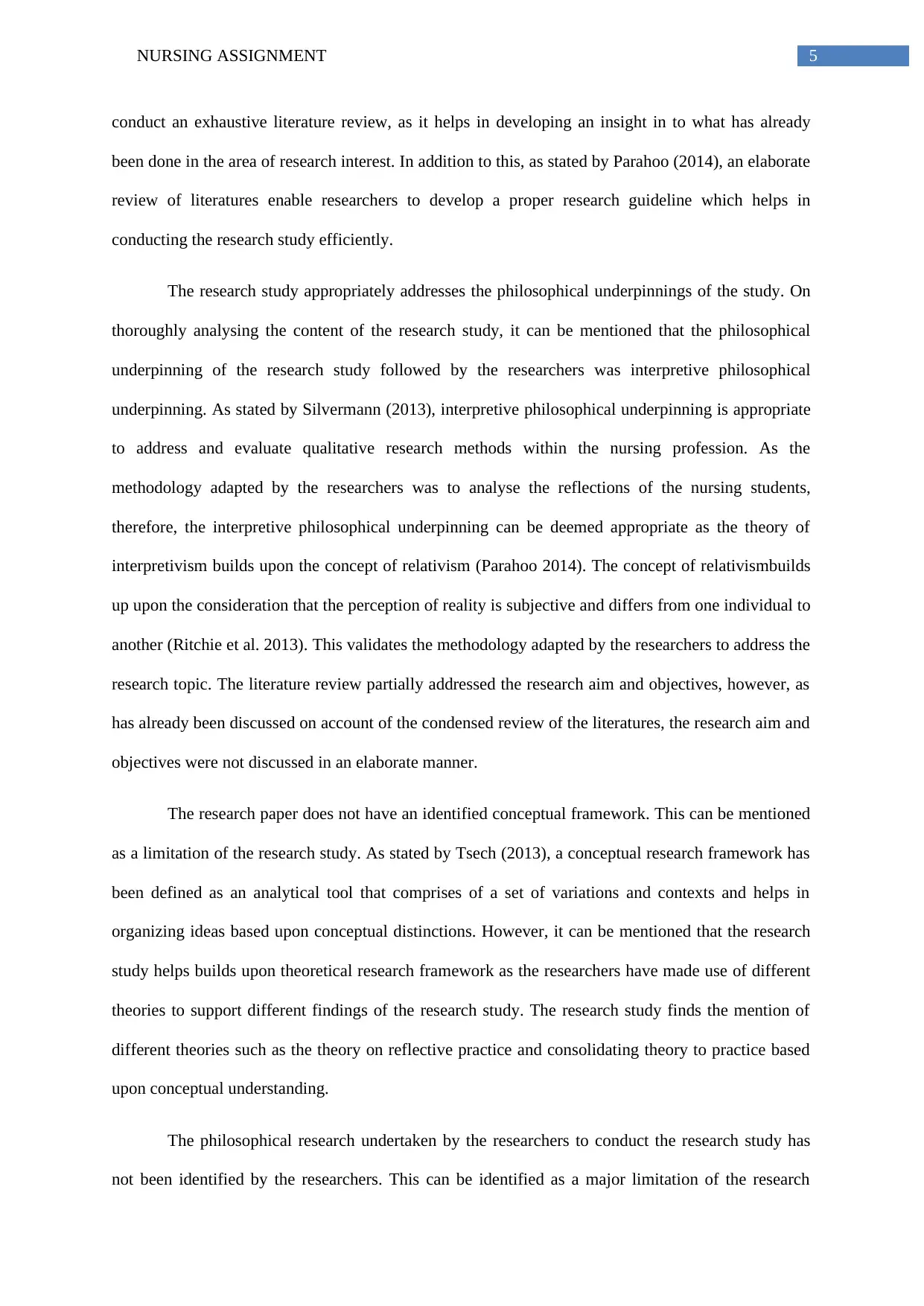
5NURSING ASSIGNMENT
conduct an exhaustive literature review, as it helps in developing an insight in to what has already
been done in the area of research interest. In addition to this, as stated by Parahoo (2014), an elaborate
review of literatures enable researchers to develop a proper research guideline which helps in
conducting the research study efficiently.
The research study appropriately addresses the philosophical underpinnings of the study. On
thoroughly analysing the content of the research study, it can be mentioned that the philosophical
underpinning of the research study followed by the researchers was interpretive philosophical
underpinning. As stated by Silvermann (2013), interpretive philosophical underpinning is appropriate
to address and evaluate qualitative research methods within the nursing profession. As the
methodology adapted by the researchers was to analyse the reflections of the nursing students,
therefore, the interpretive philosophical underpinning can be deemed appropriate as the theory of
interpretivism builds upon the concept of relativism (Parahoo 2014). The concept of relativismbuilds
up upon the consideration that the perception of reality is subjective and differs from one individual to
another (Ritchie et al. 2013). This validates the methodology adapted by the researchers to address the
research topic. The literature review partially addressed the research aim and objectives, however, as
has already been discussed on account of the condensed review of the literatures, the research aim and
objectives were not discussed in an elaborate manner.
The research paper does not have an identified conceptual framework. This can be mentioned
as a limitation of the research study. As stated by Tsech (2013), a conceptual research framework has
been defined as an analytical tool that comprises of a set of variations and contexts and helps in
organizing ideas based upon conceptual distinctions. However, it can be mentioned that the research
study helps builds upon theoretical research framework as the researchers have made use of different
theories to support different findings of the research study. The research study finds the mention of
different theories such as the theory on reflective practice and consolidating theory to practice based
upon conceptual understanding.
The philosophical research undertaken by the researchers to conduct the research study has
not been identified by the researchers. This can be identified as a major limitation of the research
conduct an exhaustive literature review, as it helps in developing an insight in to what has already
been done in the area of research interest. In addition to this, as stated by Parahoo (2014), an elaborate
review of literatures enable researchers to develop a proper research guideline which helps in
conducting the research study efficiently.
The research study appropriately addresses the philosophical underpinnings of the study. On
thoroughly analysing the content of the research study, it can be mentioned that the philosophical
underpinning of the research study followed by the researchers was interpretive philosophical
underpinning. As stated by Silvermann (2013), interpretive philosophical underpinning is appropriate
to address and evaluate qualitative research methods within the nursing profession. As the
methodology adapted by the researchers was to analyse the reflections of the nursing students,
therefore, the interpretive philosophical underpinning can be deemed appropriate as the theory of
interpretivism builds upon the concept of relativism (Parahoo 2014). The concept of relativismbuilds
up upon the consideration that the perception of reality is subjective and differs from one individual to
another (Ritchie et al. 2013). This validates the methodology adapted by the researchers to address the
research topic. The literature review partially addressed the research aim and objectives, however, as
has already been discussed on account of the condensed review of the literatures, the research aim and
objectives were not discussed in an elaborate manner.
The research paper does not have an identified conceptual framework. This can be mentioned
as a limitation of the research study. As stated by Tsech (2013), a conceptual research framework has
been defined as an analytical tool that comprises of a set of variations and contexts and helps in
organizing ideas based upon conceptual distinctions. However, it can be mentioned that the research
study helps builds upon theoretical research framework as the researchers have made use of different
theories to support different findings of the research study. The research study finds the mention of
different theories such as the theory on reflective practice and consolidating theory to practice based
upon conceptual understanding.
The philosophical research undertaken by the researchers to conduct the research study has
not been identified by the researchers. This can be identified as a major limitation of the research
⊘ This is a preview!⊘
Do you want full access?
Subscribe today to unlock all pages.

Trusted by 1+ million students worldwide
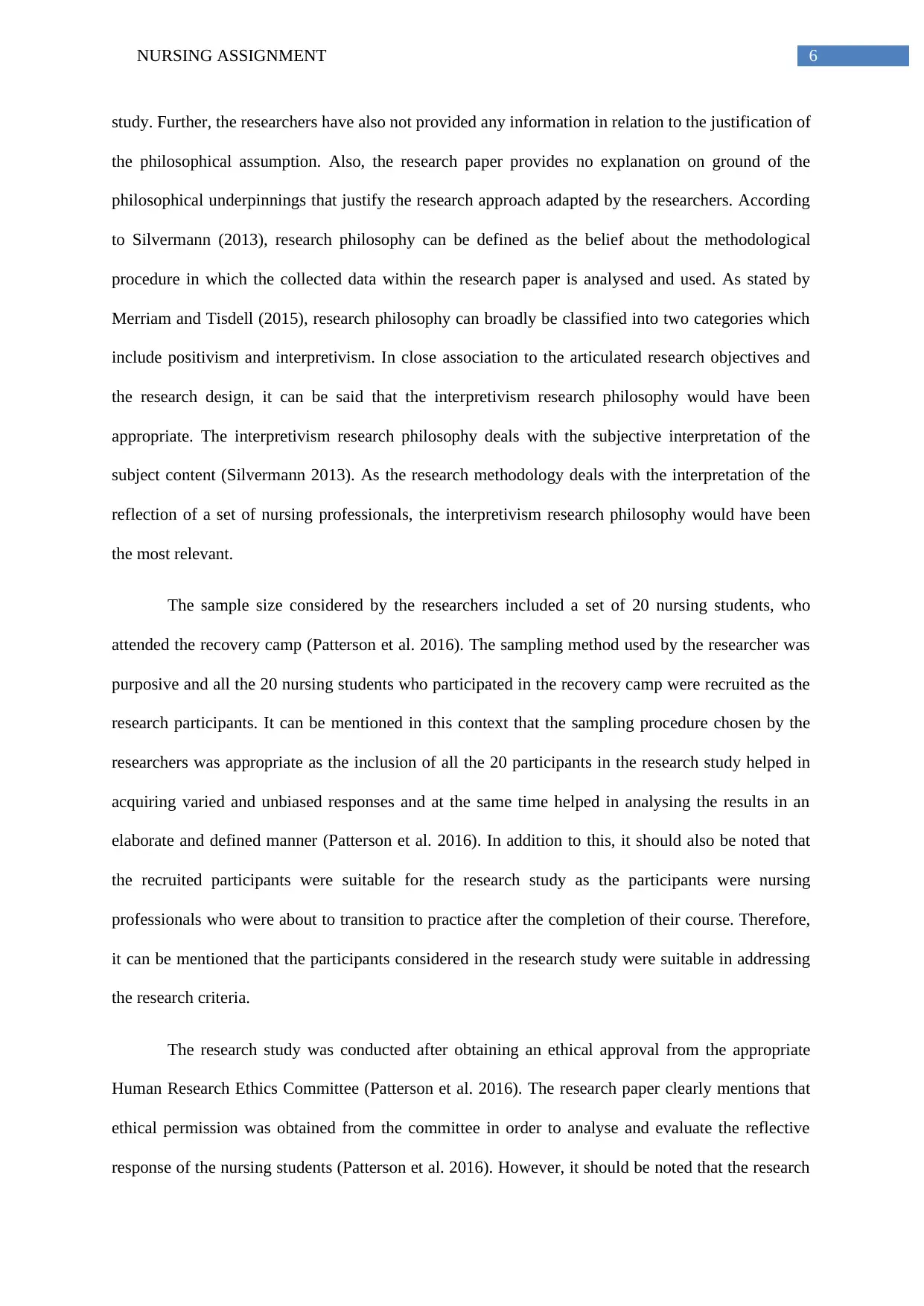
6NURSING ASSIGNMENT
study. Further, the researchers have also not provided any information in relation to the justification of
the philosophical assumption. Also, the research paper provides no explanation on ground of the
philosophical underpinnings that justify the research approach adapted by the researchers. According
to Silvermann (2013), research philosophy can be defined as the belief about the methodological
procedure in which the collected data within the research paper is analysed and used. As stated by
Merriam and Tisdell (2015), research philosophy can broadly be classified into two categories which
include positivism and interpretivism. In close association to the articulated research objectives and
the research design, it can be said that the interpretivism research philosophy would have been
appropriate. The interpretivism research philosophy deals with the subjective interpretation of the
subject content (Silvermann 2013). As the research methodology deals with the interpretation of the
reflection of a set of nursing professionals, the interpretivism research philosophy would have been
the most relevant.
The sample size considered by the researchers included a set of 20 nursing students, who
attended the recovery camp (Patterson et al. 2016). The sampling method used by the researcher was
purposive and all the 20 nursing students who participated in the recovery camp were recruited as the
research participants. It can be mentioned in this context that the sampling procedure chosen by the
researchers was appropriate as the inclusion of all the 20 participants in the research study helped in
acquiring varied and unbiased responses and at the same time helped in analysing the results in an
elaborate and defined manner (Patterson et al. 2016). In addition to this, it should also be noted that
the recruited participants were suitable for the research study as the participants were nursing
professionals who were about to transition to practice after the completion of their course. Therefore,
it can be mentioned that the participants considered in the research study were suitable in addressing
the research criteria.
The research study was conducted after obtaining an ethical approval from the appropriate
Human Research Ethics Committee (Patterson et al. 2016). The research paper clearly mentions that
ethical permission was obtained from the committee in order to analyse and evaluate the reflective
response of the nursing students (Patterson et al. 2016). However, it should be noted that the research
study. Further, the researchers have also not provided any information in relation to the justification of
the philosophical assumption. Also, the research paper provides no explanation on ground of the
philosophical underpinnings that justify the research approach adapted by the researchers. According
to Silvermann (2013), research philosophy can be defined as the belief about the methodological
procedure in which the collected data within the research paper is analysed and used. As stated by
Merriam and Tisdell (2015), research philosophy can broadly be classified into two categories which
include positivism and interpretivism. In close association to the articulated research objectives and
the research design, it can be said that the interpretivism research philosophy would have been
appropriate. The interpretivism research philosophy deals with the subjective interpretation of the
subject content (Silvermann 2013). As the research methodology deals with the interpretation of the
reflection of a set of nursing professionals, the interpretivism research philosophy would have been
the most relevant.
The sample size considered by the researchers included a set of 20 nursing students, who
attended the recovery camp (Patterson et al. 2016). The sampling method used by the researcher was
purposive and all the 20 nursing students who participated in the recovery camp were recruited as the
research participants. It can be mentioned in this context that the sampling procedure chosen by the
researchers was appropriate as the inclusion of all the 20 participants in the research study helped in
acquiring varied and unbiased responses and at the same time helped in analysing the results in an
elaborate and defined manner (Patterson et al. 2016). In addition to this, it should also be noted that
the recruited participants were suitable for the research study as the participants were nursing
professionals who were about to transition to practice after the completion of their course. Therefore,
it can be mentioned that the participants considered in the research study were suitable in addressing
the research criteria.
The research study was conducted after obtaining an ethical approval from the appropriate
Human Research Ethics Committee (Patterson et al. 2016). The research paper clearly mentions that
ethical permission was obtained from the committee in order to analyse and evaluate the reflective
response of the nursing students (Patterson et al. 2016). However, it should be noted that the research
Paraphrase This Document
Need a fresh take? Get an instant paraphrase of this document with our AI Paraphraser
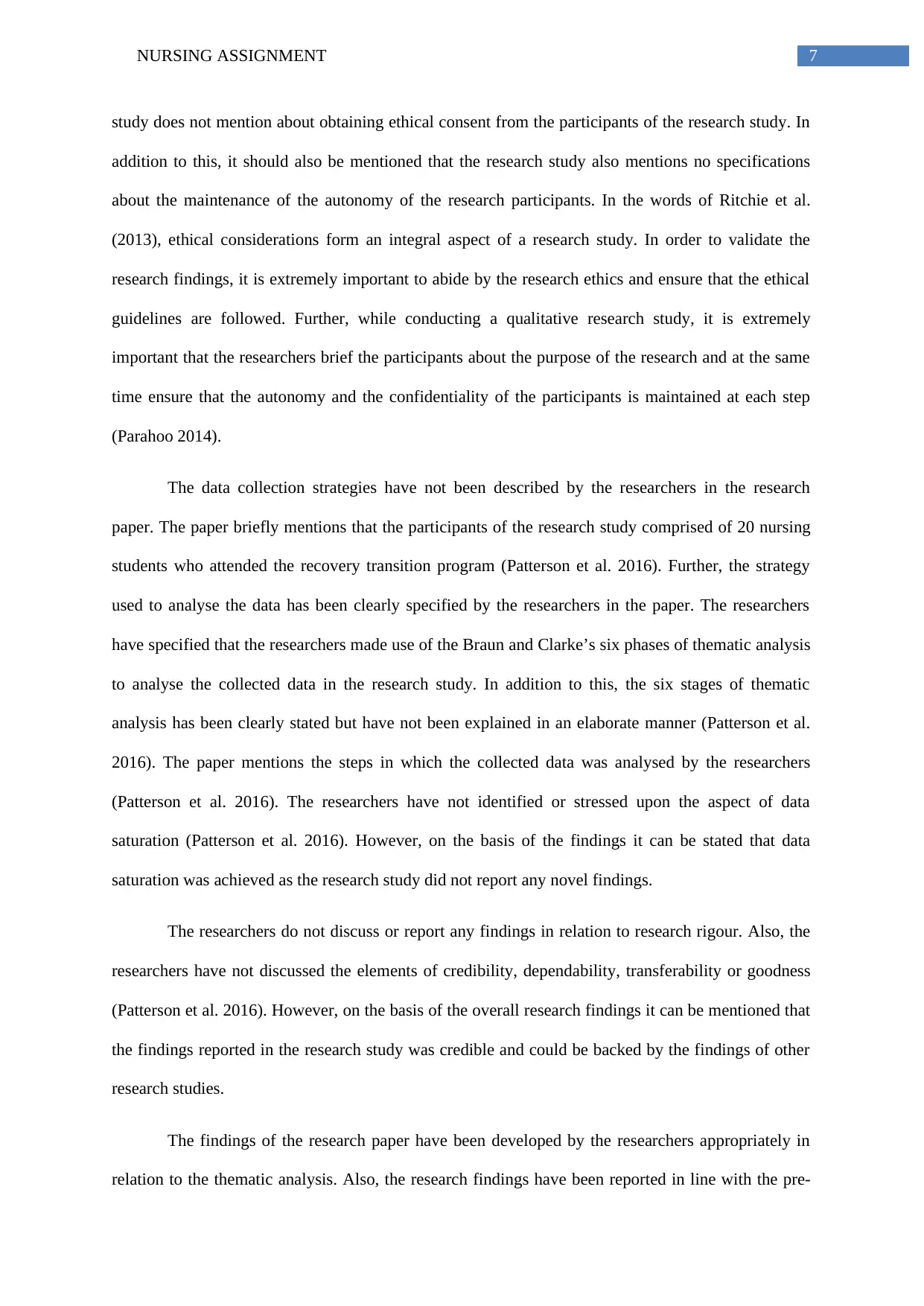
7NURSING ASSIGNMENT
study does not mention about obtaining ethical consent from the participants of the research study. In
addition to this, it should also be mentioned that the research study also mentions no specifications
about the maintenance of the autonomy of the research participants. In the words of Ritchie et al.
(2013), ethical considerations form an integral aspect of a research study. In order to validate the
research findings, it is extremely important to abide by the research ethics and ensure that the ethical
guidelines are followed. Further, while conducting a qualitative research study, it is extremely
important that the researchers brief the participants about the purpose of the research and at the same
time ensure that the autonomy and the confidentiality of the participants is maintained at each step
(Parahoo 2014).
The data collection strategies have not been described by the researchers in the research
paper. The paper briefly mentions that the participants of the research study comprised of 20 nursing
students who attended the recovery transition program (Patterson et al. 2016). Further, the strategy
used to analyse the data has been clearly specified by the researchers in the paper. The researchers
have specified that the researchers made use of the Braun and Clarke’s six phases of thematic analysis
to analyse the collected data in the research study. In addition to this, the six stages of thematic
analysis has been clearly stated but have not been explained in an elaborate manner (Patterson et al.
2016). The paper mentions the steps in which the collected data was analysed by the researchers
(Patterson et al. 2016). The researchers have not identified or stressed upon the aspect of data
saturation (Patterson et al. 2016). However, on the basis of the findings it can be stated that data
saturation was achieved as the research study did not report any novel findings.
The researchers do not discuss or report any findings in relation to research rigour. Also, the
researchers have not discussed the elements of credibility, dependability, transferability or goodness
(Patterson et al. 2016). However, on the basis of the overall research findings it can be mentioned that
the findings reported in the research study was credible and could be backed by the findings of other
research studies.
The findings of the research paper have been developed by the researchers appropriately in
relation to the thematic analysis. Also, the research findings have been reported in line with the pre-
study does not mention about obtaining ethical consent from the participants of the research study. In
addition to this, it should also be mentioned that the research study also mentions no specifications
about the maintenance of the autonomy of the research participants. In the words of Ritchie et al.
(2013), ethical considerations form an integral aspect of a research study. In order to validate the
research findings, it is extremely important to abide by the research ethics and ensure that the ethical
guidelines are followed. Further, while conducting a qualitative research study, it is extremely
important that the researchers brief the participants about the purpose of the research and at the same
time ensure that the autonomy and the confidentiality of the participants is maintained at each step
(Parahoo 2014).
The data collection strategies have not been described by the researchers in the research
paper. The paper briefly mentions that the participants of the research study comprised of 20 nursing
students who attended the recovery transition program (Patterson et al. 2016). Further, the strategy
used to analyse the data has been clearly specified by the researchers in the paper. The researchers
have specified that the researchers made use of the Braun and Clarke’s six phases of thematic analysis
to analyse the collected data in the research study. In addition to this, the six stages of thematic
analysis has been clearly stated but have not been explained in an elaborate manner (Patterson et al.
2016). The paper mentions the steps in which the collected data was analysed by the researchers
(Patterson et al. 2016). The researchers have not identified or stressed upon the aspect of data
saturation (Patterson et al. 2016). However, on the basis of the findings it can be stated that data
saturation was achieved as the research study did not report any novel findings.
The researchers do not discuss or report any findings in relation to research rigour. Also, the
researchers have not discussed the elements of credibility, dependability, transferability or goodness
(Patterson et al. 2016). However, on the basis of the overall research findings it can be mentioned that
the findings reported in the research study was credible and could be backed by the findings of other
research studies.
The findings of the research paper have been developed by the researchers appropriately in
relation to the thematic analysis. Also, the research findings have been reported in line with the pre-
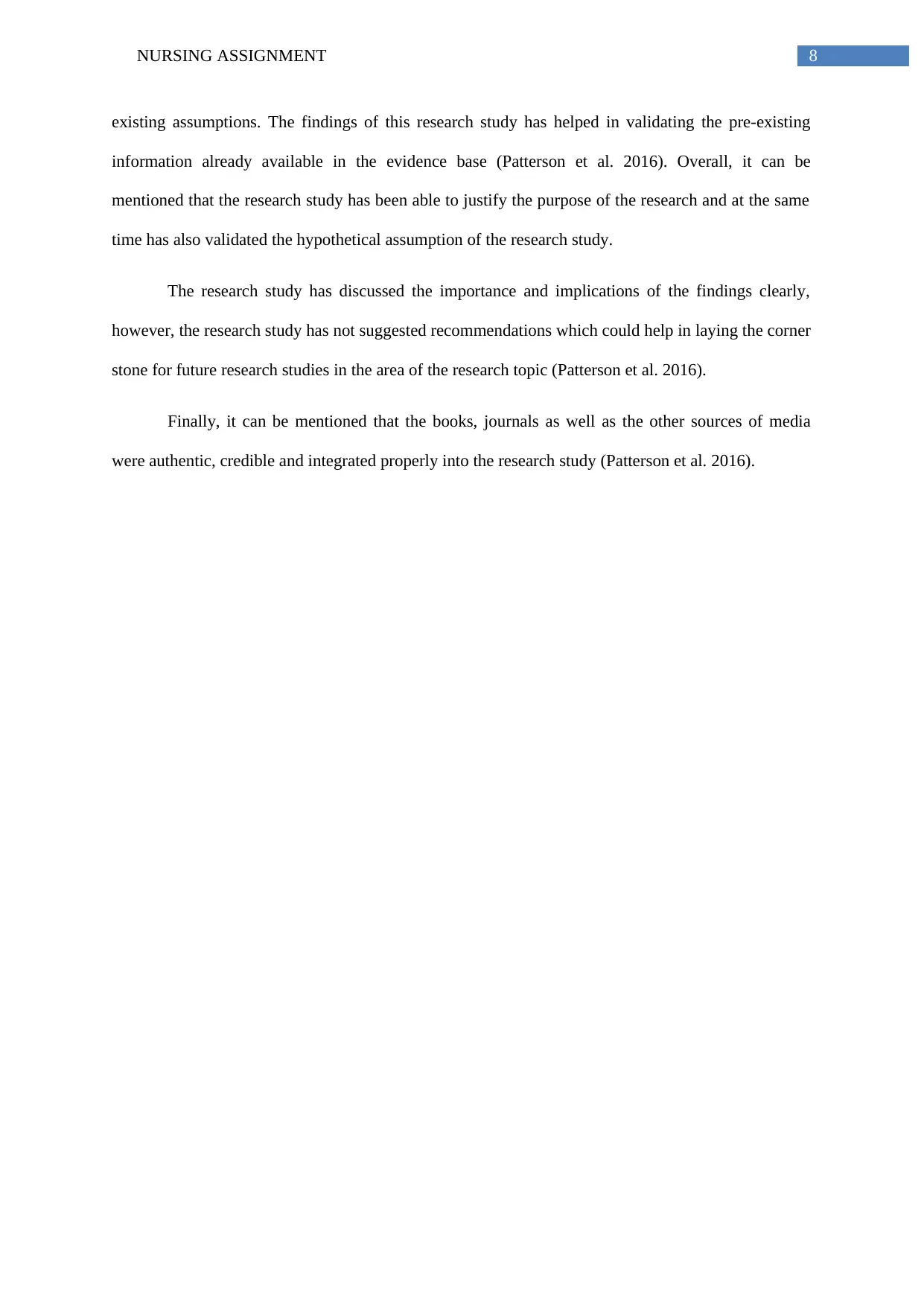
8NURSING ASSIGNMENT
existing assumptions. The findings of this research study has helped in validating the pre-existing
information already available in the evidence base (Patterson et al. 2016). Overall, it can be
mentioned that the research study has been able to justify the purpose of the research and at the same
time has also validated the hypothetical assumption of the research study.
The research study has discussed the importance and implications of the findings clearly,
however, the research study has not suggested recommendations which could help in laying the corner
stone for future research studies in the area of the research topic (Patterson et al. 2016).
Finally, it can be mentioned that the books, journals as well as the other sources of media
were authentic, credible and integrated properly into the research study (Patterson et al. 2016).
existing assumptions. The findings of this research study has helped in validating the pre-existing
information already available in the evidence base (Patterson et al. 2016). Overall, it can be
mentioned that the research study has been able to justify the purpose of the research and at the same
time has also validated the hypothetical assumption of the research study.
The research study has discussed the importance and implications of the findings clearly,
however, the research study has not suggested recommendations which could help in laying the corner
stone for future research studies in the area of the research topic (Patterson et al. 2016).
Finally, it can be mentioned that the books, journals as well as the other sources of media
were authentic, credible and integrated properly into the research study (Patterson et al. 2016).
⊘ This is a preview!⊘
Do you want full access?
Subscribe today to unlock all pages.

Trusted by 1+ million students worldwide
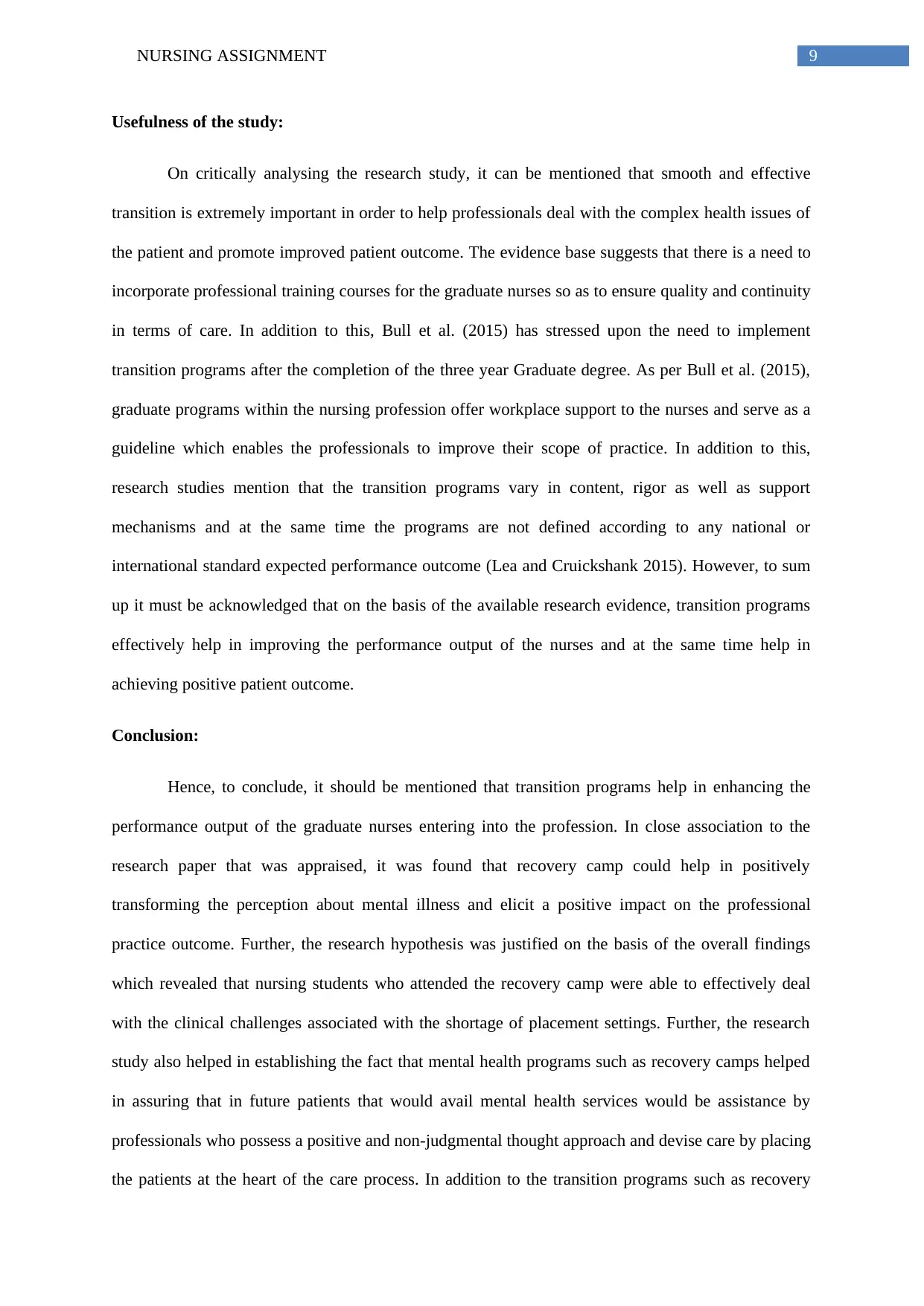
9NURSING ASSIGNMENT
Usefulness of the study:
On critically analysing the research study, it can be mentioned that smooth and effective
transition is extremely important in order to help professionals deal with the complex health issues of
the patient and promote improved patient outcome. The evidence base suggests that there is a need to
incorporate professional training courses for the graduate nurses so as to ensure quality and continuity
in terms of care. In addition to this, Bull et al. (2015) has stressed upon the need to implement
transition programs after the completion of the three year Graduate degree. As per Bull et al. (2015),
graduate programs within the nursing profession offer workplace support to the nurses and serve as a
guideline which enables the professionals to improve their scope of practice. In addition to this,
research studies mention that the transition programs vary in content, rigor as well as support
mechanisms and at the same time the programs are not defined according to any national or
international standard expected performance outcome (Lea and Cruickshank 2015). However, to sum
up it must be acknowledged that on the basis of the available research evidence, transition programs
effectively help in improving the performance output of the nurses and at the same time help in
achieving positive patient outcome.
Conclusion:
Hence, to conclude, it should be mentioned that transition programs help in enhancing the
performance output of the graduate nurses entering into the profession. In close association to the
research paper that was appraised, it was found that recovery camp could help in positively
transforming the perception about mental illness and elicit a positive impact on the professional
practice outcome. Further, the research hypothesis was justified on the basis of the overall findings
which revealed that nursing students who attended the recovery camp were able to effectively deal
with the clinical challenges associated with the shortage of placement settings. Further, the research
study also helped in establishing the fact that mental health programs such as recovery camps helped
in assuring that in future patients that would avail mental health services would be assistance by
professionals who possess a positive and non-judgmental thought approach and devise care by placing
the patients at the heart of the care process. In addition to the transition programs such as recovery
Usefulness of the study:
On critically analysing the research study, it can be mentioned that smooth and effective
transition is extremely important in order to help professionals deal with the complex health issues of
the patient and promote improved patient outcome. The evidence base suggests that there is a need to
incorporate professional training courses for the graduate nurses so as to ensure quality and continuity
in terms of care. In addition to this, Bull et al. (2015) has stressed upon the need to implement
transition programs after the completion of the three year Graduate degree. As per Bull et al. (2015),
graduate programs within the nursing profession offer workplace support to the nurses and serve as a
guideline which enables the professionals to improve their scope of practice. In addition to this,
research studies mention that the transition programs vary in content, rigor as well as support
mechanisms and at the same time the programs are not defined according to any national or
international standard expected performance outcome (Lea and Cruickshank 2015). However, to sum
up it must be acknowledged that on the basis of the available research evidence, transition programs
effectively help in improving the performance output of the nurses and at the same time help in
achieving positive patient outcome.
Conclusion:
Hence, to conclude, it should be mentioned that transition programs help in enhancing the
performance output of the graduate nurses entering into the profession. In close association to the
research paper that was appraised, it was found that recovery camp could help in positively
transforming the perception about mental illness and elicit a positive impact on the professional
practice outcome. Further, the research hypothesis was justified on the basis of the overall findings
which revealed that nursing students who attended the recovery camp were able to effectively deal
with the clinical challenges associated with the shortage of placement settings. Further, the research
study also helped in establishing the fact that mental health programs such as recovery camps helped
in assuring that in future patients that would avail mental health services would be assistance by
professionals who possess a positive and non-judgmental thought approach and devise care by placing
the patients at the heart of the care process. In addition to the transition programs such as recovery
Paraphrase This Document
Need a fresh take? Get an instant paraphrase of this document with our AI Paraphraser
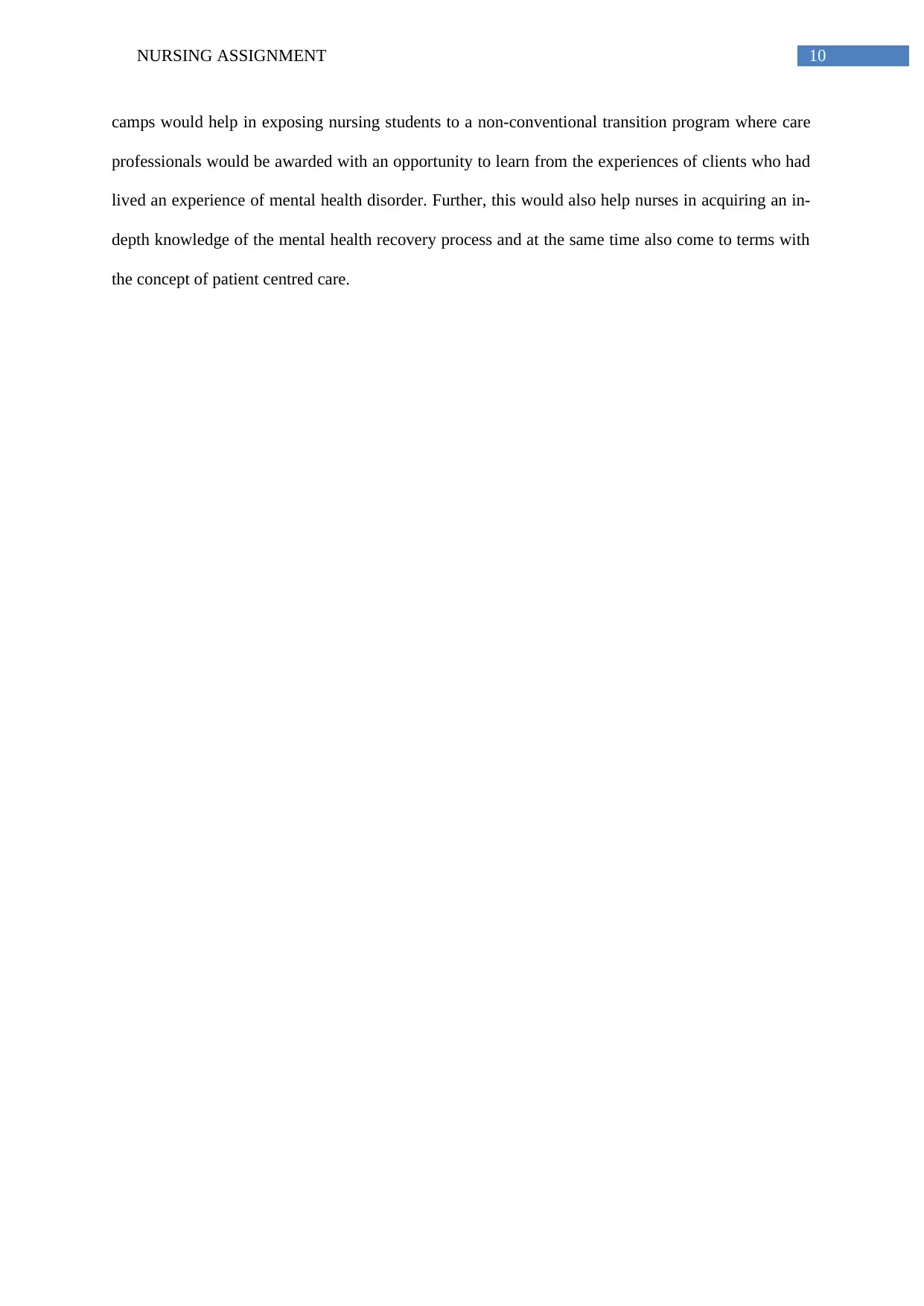
10NURSING ASSIGNMENT
camps would help in exposing nursing students to a non-conventional transition program where care
professionals would be awarded with an opportunity to learn from the experiences of clients who had
lived an experience of mental health disorder. Further, this would also help nurses in acquiring an in-
depth knowledge of the mental health recovery process and at the same time also come to terms with
the concept of patient centred care.
camps would help in exposing nursing students to a non-conventional transition program where care
professionals would be awarded with an opportunity to learn from the experiences of clients who had
lived an experience of mental health disorder. Further, this would also help nurses in acquiring an in-
depth knowledge of the mental health recovery process and at the same time also come to terms with
the concept of patient centred care.
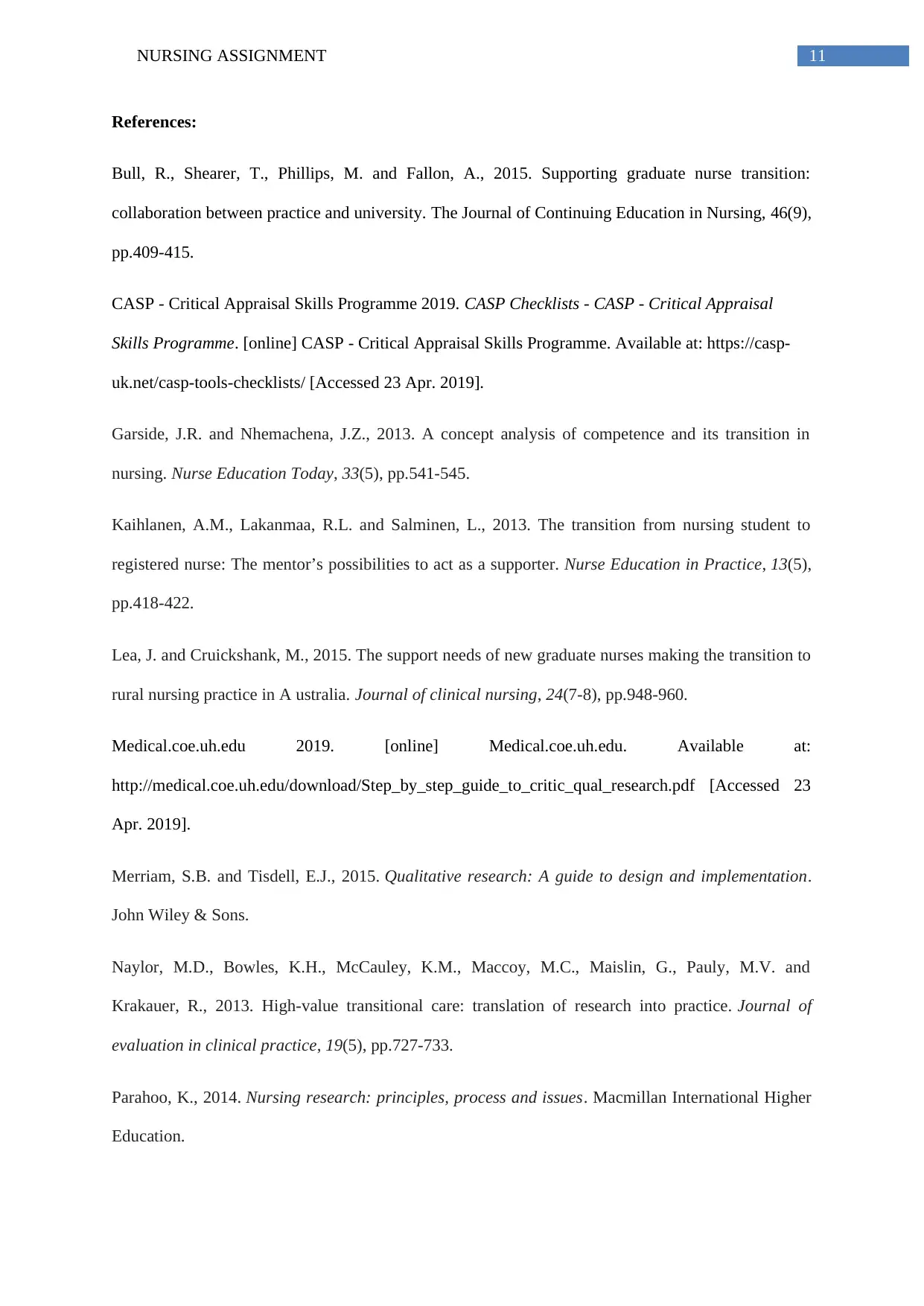
11NURSING ASSIGNMENT
References:
Bull, R., Shearer, T., Phillips, M. and Fallon, A., 2015. Supporting graduate nurse transition:
collaboration between practice and university. The Journal of Continuing Education in Nursing, 46(9),
pp.409-415.
CASP - Critical Appraisal Skills Programme 2019. CASP Checklists - CASP - Critical Appraisal
Skills Programme. [online] CASP - Critical Appraisal Skills Programme. Available at: https://casp-
uk.net/casp-tools-checklists/ [Accessed 23 Apr. 2019].
Garside, J.R. and Nhemachena, J.Z., 2013. A concept analysis of competence and its transition in
nursing. Nurse Education Today, 33(5), pp.541-545.
Kaihlanen, A.M., Lakanmaa, R.L. and Salminen, L., 2013. The transition from nursing student to
registered nurse: The mentor’s possibilities to act as a supporter. Nurse Education in Practice, 13(5),
pp.418-422.
Lea, J. and Cruickshank, M., 2015. The support needs of new graduate nurses making the transition to
rural nursing practice in A ustralia. Journal of clinical nursing, 24(7-8), pp.948-960.
Medical.coe.uh.edu 2019. [online] Medical.coe.uh.edu. Available at:
http://medical.coe.uh.edu/download/Step_by_step_guide_to_critic_qual_research.pdf [Accessed 23
Apr. 2019].
Merriam, S.B. and Tisdell, E.J., 2015. Qualitative research: A guide to design and implementation.
John Wiley & Sons.
Naylor, M.D., Bowles, K.H., McCauley, K.M., Maccoy, M.C., Maislin, G., Pauly, M.V. and
Krakauer, R., 2013. High‐value transitional care: translation of research into practice. Journal of
evaluation in clinical practice, 19(5), pp.727-733.
Parahoo, K., 2014. Nursing research: principles, process and issues. Macmillan International Higher
Education.
References:
Bull, R., Shearer, T., Phillips, M. and Fallon, A., 2015. Supporting graduate nurse transition:
collaboration between practice and university. The Journal of Continuing Education in Nursing, 46(9),
pp.409-415.
CASP - Critical Appraisal Skills Programme 2019. CASP Checklists - CASP - Critical Appraisal
Skills Programme. [online] CASP - Critical Appraisal Skills Programme. Available at: https://casp-
uk.net/casp-tools-checklists/ [Accessed 23 Apr. 2019].
Garside, J.R. and Nhemachena, J.Z., 2013. A concept analysis of competence and its transition in
nursing. Nurse Education Today, 33(5), pp.541-545.
Kaihlanen, A.M., Lakanmaa, R.L. and Salminen, L., 2013. The transition from nursing student to
registered nurse: The mentor’s possibilities to act as a supporter. Nurse Education in Practice, 13(5),
pp.418-422.
Lea, J. and Cruickshank, M., 2015. The support needs of new graduate nurses making the transition to
rural nursing practice in A ustralia. Journal of clinical nursing, 24(7-8), pp.948-960.
Medical.coe.uh.edu 2019. [online] Medical.coe.uh.edu. Available at:
http://medical.coe.uh.edu/download/Step_by_step_guide_to_critic_qual_research.pdf [Accessed 23
Apr. 2019].
Merriam, S.B. and Tisdell, E.J., 2015. Qualitative research: A guide to design and implementation.
John Wiley & Sons.
Naylor, M.D., Bowles, K.H., McCauley, K.M., Maccoy, M.C., Maislin, G., Pauly, M.V. and
Krakauer, R., 2013. High‐value transitional care: translation of research into practice. Journal of
evaluation in clinical practice, 19(5), pp.727-733.
Parahoo, K., 2014. Nursing research: principles, process and issues. Macmillan International Higher
Education.
⊘ This is a preview!⊘
Do you want full access?
Subscribe today to unlock all pages.

Trusted by 1+ million students worldwide
1 out of 13
Related Documents
Your All-in-One AI-Powered Toolkit for Academic Success.
+13062052269
info@desklib.com
Available 24*7 on WhatsApp / Email
![[object Object]](/_next/static/media/star-bottom.7253800d.svg)
Unlock your academic potential
Copyright © 2020–2025 A2Z Services. All Rights Reserved. Developed and managed by ZUCOL.





